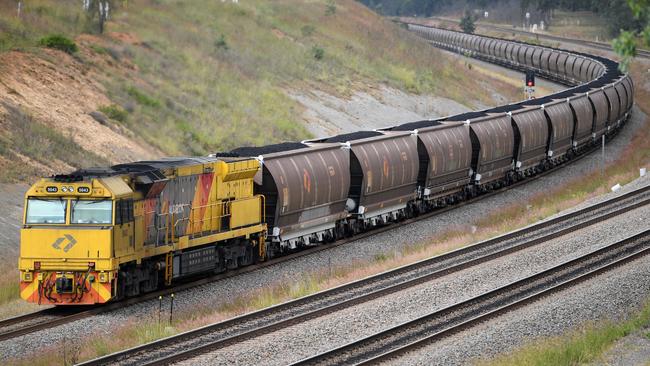Coal exports halve in 20 years in Aurizon’s worst case scenario
Australian coal exports could halve in the next 20 years, rail haulage group Aurizon says.

Business
Don't miss out on the headlines from Business. Followed categories will be added to My News.
Australian coal exports could halve over the next two decades if major Asian nations rapidly decarbonise their energy networks, according to rail hauler Aurizon – or rise by more than 25 per cent to more than 500 million tonnes.
Aurizon sketched out the worst-case scenario for Australian coal in an investors presentation on Wednesday, telling analysts and shareholders it had modelled the impact of a range of scenarios on its Australian rail haulage business, as the company looks to expand its business of hauling lithium, rare earths and other battery-making commodities.
Despite acknowledging the impact of China’s bans on Australian metallurgical and thermal coal, which have hit the company’s rail haulage volumes this financial year, chief executive Andrew Harding confirmed Aurizon was on track to hit guidance of $870m to $910m in earnings before interest and tax this financial year, and generate free cash flow of about $700m.
Chief financial officer George Lippiatt used Aurizon’s investor day to outline the range of scenarios used by the rail hauler to try to plan for the future, saying Australian coal export volumes – traditionally the predictor of Aurizon’s likely profits and returns to shareholders – could vary widely over the next decade.
He noted that Aurizon’s scenario analysis was not designed to predict the shifting coal market, but to inform the company’s decision-making as trends emerged.
“They are possible scenarios that we use in various ways in our business, including the way we think about our strategy, about the allocation of capital, and importantly about sustainability in the context of climate change risks,” he said.

The most optimistic scenario, in which Asian economic growth accelerates with little or no change in current climate change policies would see Australian coal exports – both metallurgical and thermal – grow to more than 500 million tonnes by 2040.
The worst-case scenario for the coal industry would see exports fall to about 200 million tonnes, of mostly metallurgical coal.
A lesser effort by Asian customers to decarbonise would see exports fall to about 300 million tonnes by 2040, as would the refusal of state and federal governments to approve new coal mines after 2025.
On current trends, with no major constraints on mine approvals and steady economic growth in Asia, Australian coal exports would grow steadily to about 450 million tonnes over the next two decades.
But Mr Lippiatt said Aurizon’s average annual cash flow remained steady under most of the scenarios, at $500m to $650m, give the likely uplift in other parts of the business, including expansions to shipments of other commodities such as battery making materials.
Mr Harding told investors Aurizon’s bulk export business – targeting copper, lithium, nickel and other non-coal commodities – could more than double to more than $200m annually due to rising demand.
“Under its ‘Stated Policies’ scenario, the International Energy Agency projects a doubling of minerals associated with clean energy technologies by 2040. In a less than two degree scenario, the IEA projects a fourfold increase over the same time period,” he said.
“As demand for such minerals grows, there are significant opportunities for Australian export volume. This is supported by increased exploration seen over the past five years and projections by the Office of Chief Economist. Already the world’s largest producer of lithium, annual growth of 16 per cent per annum is projected over the six years.”
Mr Harding said the trend would reduce Aurizon’s reliance on thermal coal exports over time, if it could capitalise on the opportunity.
“These new markets provide a much larger potential profit pool which underpins our aspiration to more than double bulk’s current EBIT to $250m over the next ten years,” he said.
“This growth opportunity could result in the commodity mix changing within Aurizon and consequently, if Aurizon is able to capitalise on these opportunities, revenue from thermal coal could be less than 20 per cent of the above rail portfolio by 2030.”
Aurizon shares closed steady at $3.79.
Originally published as Coal exports halve in 20 years in Aurizon’s worst case scenario



